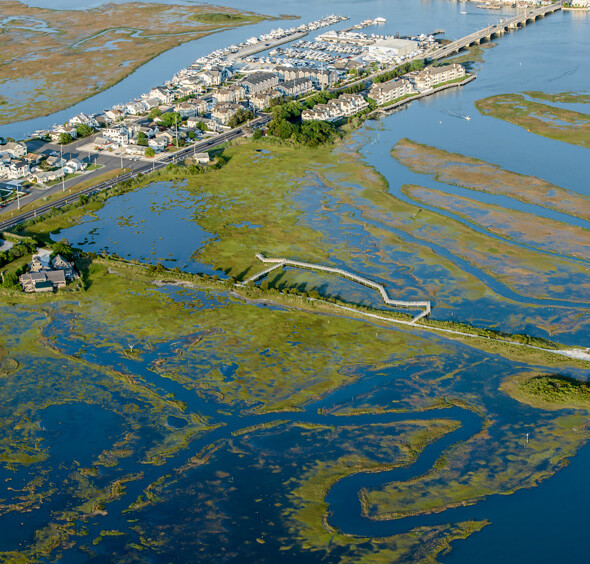STONE HARBOR – The executive director of The Wetlands Institute outlined the latest marsh enhancement project of the Seven Mile Island Innovation Lab as part of an overview of the lab’s work during the Aug. 20 meeting of the Borough Council.
Lenore Tedesco, the executive director, said the newest project to use dredge materials to rebuild marshes, at an area adjacent to the Institute, will be unique because it will be visible to the public.
The Seven Mile Island Innovation Lab was established in 2019 as a partnership of the Army Corps of Engineers, the state Division of Fish and Wildlife and The Wetlands Institute.
The initiative has resulted in several projects that use dredge materials to restore sinking marshes, developing techniques, producing innovative research and sharing knowledge as byproducts of the effort.

The Scotch Bonnet Island project will seek to save marshes that are literally drowning as they fall behind sea-level rise rates.
The marshes will benefit from dredging of the Intracoastal Waterway, using channel sediments to uplift low marsh areas.
The location of the project means the work will be visible from Stone Harbor Boulevard and The Wetlands Institute, providing the public with a firsthand view of marsh restoration.
Typically the sediments from channel dredging would be moved to a nearby site to dewater before being trucked to the mainland. It is an expensive, time-consuming process that puts no value on the sediments.
The Innovation Lab is exploring ways to beneficially use the sediment and rebuild marshland.
One of the things that makes the work of the Lab so important, Tedesco explained, is the critical role marshes play as vital ecosystems for birds and shellfish and as protective barriers that aid in the reduction of flooding. As an example, she cited the marshes around Ocean City, which she said reduce tidal flooding by 20% each year.
Marshes play a vital role in the battle with climate change and sea-level rise, but the marshes are themselves becoming victims of rising seas. “About 80,000 acres of coastal wetlands are lost each year,” she said, with sea-level rise a major contributor to that loss.
Tedesco said that a variety of conditions are producing faster sea-level rise in New Jersey than the global averages. Marshes survive at about sea level, she said, advancing and retreating as they can. The crisis now is that the marshes cannot keep up with the rate of sea rise.
“The marshes are drowning,” she bluntly put it; coastal resiliency is at risk. The good news is that the shore communities in Cape May County have a great natural resource with which to resist the negative effects of sea-level rise: Their extensive wetlands. Saving them is ultimately a way of saving ourselves, she said.
The plan calls for using roughly 25,000 cubic yards of dredge material to build up about 10 acres of marsh by nearly 2 feet. The project should begin in early fall, leaving the winter months for settling of the material before wildlife returns in the spring.
Tedesco said the proximity of Scotch Bonnet Island makes this project ideal for educating the public about the importance of the marshes. As silt and mud are sprayed onto the low marsh areas, the result may look like little more than mud piles in the wetlands. Tedesco said natural growth will return the now higher marshes to their current appearance in about five years.
Financial support for the project comes from the Army Corps of Engineers. Donors are contributing to the research work being done at the Institute.
Success carries with it the promise of similar activities up and down the East Coast. The long expanse of the Intracoastal Waterway means dredging is an almost constant activity that could benefit numerous marsh areas.
Marshes thrive with intermittent flooding; they fail under circumstances that Tedesco described as repetitive deep flooding that destroys life.
This marsh rebuilding project, with an estimated duration of six to eight weeks, will seek to reset the balance that allows marshes to continue to be one of the most complex ecosystems in the world while simultaneously offering shore communities a natural, living barrier to sea-level rise.
Contact the reporter, Vince Conti, at vconti@cmcherald.com.








